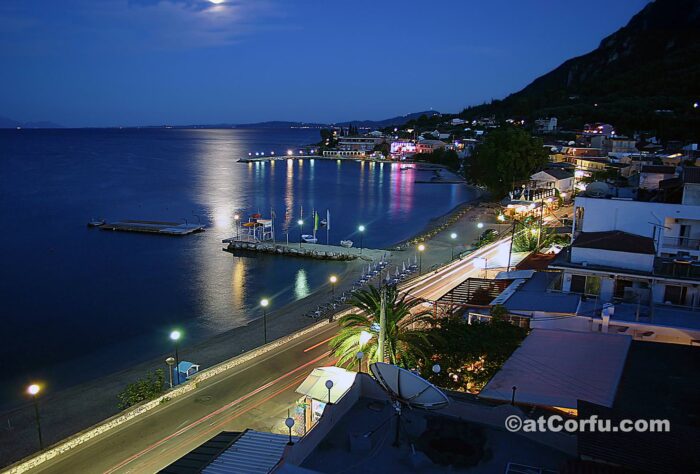
Benitses is perhaps one of the most famous seaside villages in all of Greece.
Located on the east coast, just 12 kilometers south of Corfu Town and 9 kilometers from Ioannis Kapodistrias International Airport, it’s one of the island’s earliest tourist destinations.
The village known for its hospitable and friendly residents who are familiar with various foreign cultures, was the first tourist resort in Corfu. Tourism on the island began here and later spread to other parts of Corfu.
Benitses is an old, traditional village that has always held a special charm for visitors. Perhaps it’s the picturesque location between the green mountains and the sea, or maybe it’s the legacy of famous visitors from the past and the vibrant nightlife that once defined it. Its rich history spans centuries, and despite the passage of time, the natural beauty of the landscape remains unchanged.
Today, Benitses offers a remarkable blend of mountain and sea, along with excellent tourist infrastructure. Visitors can choose from hotels of all categories, rental rooms, restaurants serving everything from traditional Greek dishes to Chinese cuisine, and nightlife options including bars and clubs. The village is also home to a Tourist Boat Refuge (Marina), offering ample mooring for dozens of tourist ships and even more small pleasure boats.
Useful telephone numbers
Pharmacy
Maria Kontostanou
Tel: 26610 71161
Emergency – Ambulance
Tel: 166
General Practice
Dr. Dimitris Tsevas
Tel: +30 2661 071204
TAXI station
Tel: 26610 33811
Police station
Tel: 26610 72222
Origin of the name Benitses

The official name of the village is Benitses, which is in the plural form, referring to a collection of settlements or areas.
However, locals often refer to it in the singular as Benitsa, leading to several variations of the name that might confuse visitors. But regardless of how it’s called, it’s all the same place.
Location and population
The old part of Benitses is built in an area of incredible beauty, located almost in the center of the island, in a valley that begins at the Agioi Deka mountain, home to the aqueduct’s sources, and winds between the mountains of Stavros and Gastouri, eventually meeting the sea.
Despite decades of intense tourism development, the village has managed to preserve its natural beauty.
It is an idyllic place with a rich history, vibrant present, and great potential for the future, a must-visit for anyone planning a trip to Corfu.
The village offers Blue Flag-awarded beaches with clean, crystal-clear waters, featuring both shingle and sand. These beaches, much larger and more developed than the basic ones of the 90s, now provide sunbeds, amenities, and plenty of water sports.
Once a major tourist destination, especially during the ’70s and ’80s, Benitses today is proud of its beautiful tourist harbor, the well-known Marina, which includes a large parking area and many other facilities.
The approximately 1,000 residents of Benitses are working to make it the most important, lively, and active part of the island after Corfu Town, and despite various challenges, this vision is slowly becoming a reality.
The village of Benitses consists of five distinct settlements.
- The old traditional part, located between the surrounding mountains, was once called Panochori.
- The settlement of Vaska (meaning reservoir) is further west, situated in the valley around the aqueduct from which it takes its name.
- The area around the port, formerly known as Skaloma, serves as the current commercial center of the village, home to most of the shops.
- The so-called “New Village” has expanded, and continues to grow southward along the Lefkimmi national road. This area is known by locals as Khodrakia, or for some, Kontrakia.
- The settlement of Tsaki, located to the far south, is the last settlement of Benitses in that direction.
The village has a population of approximately 1,000 residents, the majority of whom work in tourism. Historically, the main occupations included fishing, citrus cultivation, olive oil production, and even the operation of water mills on the village’s mountainside for flour production. Some of these traditional activities, like fishing, have been revived, especially during the winter months.
The water mills likely existed for centuries, thanks to the natural springs that fed a river, which once flowed through what is now the main road of the old village. The river was diverted at the start of the 20th century. The aqueduct at these springs is the reason why Benitses has been inhabited since ancient times, and the village’s name itself is derived from the river.
For more detailed historical references, facts, and information, please visit the dedicated page on the history of our village.
The main street is lined with various shops, including supermarkets, tourist offices, souvenir stores, car and motorbike rentals, restaurants, cafés, bars, and more.
Benitses is nestled against the green mountains covered with olive and cypress trees, where several secluded churches, such as Agia Paraskevi and Agia Triada, are located on hills of unique beauty. This makes it an ideal destination for hiking and cycling along the many paths that lead to the mountain village of Stavros, offering breathtaking views of much of the island.
What does Benitses offer today?
For prospective visitors, it’s important to note that Benitses in 2016 is nothing like the bustling, noisy tourist hub it was in the 80s.
- The village has seen significant infrastructure improvements, particularly in accommodation options such as hotels, apartments, and rooms, as well as in its variety of shops.
- Every hotel or room complex, whether large or small, offers free broadband internet access to all guests.
- Benitses is now home to some of the best restaurants on the island, both in terms of quality and taste, making it a true gastronomic paradise.
- Additionally, Benitses is one of the safest destinations on the island. The noisy tourism of the 80s is long gone, leaving a quieter, more serene atmosphere.
- Its central location on the island makes Benitses an ideal base for exploring the rest of Corfu. The best sandy beaches, located on the west and south coasts, are only a short drive away.
- From the tourist marina, small and large boats depart daily for cruises to beautiful parts of Corfu, the nearby mainland, and the idyllic island of Paxos. Stunning locations such as Sivota on the mainland are just one to two hours away.
Today, Benitses has enhanced its traditional charm, improved its infrastructure, and offers a secure environment, making it an ideal destination for families with children, couples, and those seeking tranquility.
The Tourist Infrastructure today
- The beaches in Benitses have seen significant improvements. They have expanded in both width and size, no longer the narrow, pebbly shores of the 80s. Today, they are large, comfortable, and equipped with supporting infrastructure.
- Each beach is well-maintained, featuring lifeguards, sunbeds with umbrellas, water sports, and, most importantly, some of the clearest, crystal-clear waters along the east coast of Corfu.
- These beaches have been awarded the prestigious Blue Flag by the European Union, making Benitses an ideal spot for swimming, sailing, and water sports.
- The village is also well-equipped with essential services, including a doctor, pharmacy, clinic, tourist offices, laundry services, and water sports facilities.
- Since the 80s, a modern wastewater treatment system has been in place, one of the first in Corfu, ensuring the area’s environmental sustainability.
Benitses remains a fantastic tourist destination, perfect for relaxation and unforgettable holidays.
The Sea in Benitses
The sea in Benitses is exceptionally clean, largely due to the presence of the marine plant Posidonia oceanica. Although its dark color at the seabed may be off-putting to some swimmers, Posidonia plays a crucial role in purifying the water by filtering out toxic substances, heavy metals, and carbon dioxide while producing oxygen.
It also provides essential shelter and food for spawning fish, contributing to both the abundance of fish and the remarkable purity of the sea. The thriving fish population here owes much to the Posidonia meadows, which enhance the marine ecosystem’s health.
While these meadows are green when alive, their stems turn dark brown as they age. Eventually, the old stems break off and wash ashore, carried by currents. To maintain clean beaches, this dead Posidonia must be removed regularly before it begins to decompose.
Contrary to popular belief, Posidonia is not seaweed. It’s a valuable marine plant that grows, flowers, and reproduces just like land plants. It belongs to the angiosperm group of flowering plants, completely unrelated to seaweed. Its enemies include trawlers and destructive fishing practices that sweep and damage the seabed, as well as general ignorance about its ecological importance.
Posidonia is a clear indicator of a clean sea and balanced environment, thriving only in the Mediterranean’s and southwestern Australia’s cleanest waters.
Activities and Attractions
There are many attractions to see and admire in the wider area of Benitses.
- Make sure to visit the Achilleion Palace, located just three kilometers north of the village center.
- Admire the large floating rock with a thin base, known as Laopetra, located in the sea at the northern entrance of the village. And, of course, don’t forget to visit the ruins of the ancient Roman baths in the center of Benitses.
- You can also take a stroll through the extensive tourist boat harbor, the well-known marina. If you enjoy walking, countless small mountain paths lead you through lush vegetation, past old abandoned churches, and other historic buildings, eventually bringing you to the mountain villages of Stavros and Agioi Deka.
- Finally, take in the extraordinary beauty of the old traditional village with its welcoming and friendly inhabitants.
Complete Benitses Travel Guide
On our pages, you will find extensive coverage of the area’s attractions, including the ruins of the Roman villa with its thermal baths, the Maritime Museum, the new marina for tourist boats, as well as the nearby Achilleion in Gastouri.
We also offer a comprehensive cultural guide detailing the village’s celebrations and events, enriched with numerous photos, aerial views, and, most notably, a large collection of very old black-and-white photos of historical value, showing how the area and its people looked in the past.
Additionally, you’ll find information about the local nightlife, as well as details on nearly all the hotels, rooms, and studios for rent, along with many restaurants, cafes, and a wide variety of shops in Benitses and the surrounding area.
Read more about Benitses
What might Benitses in Corfu have been like?
Benitses in Corfu is a village with deep historical roots, and after Corfu’s Old Town, it stands as the island’s oldest tourist resort.
6 Reasons To Visit The Village of Benitses Corfu
Benitses was the first tourist destination on Corfu since the 1960s. But why you should visit Benitses now? We give you at least 6 good reasons to do it!
Corfu Sea Shell Museum in Benitses
In Benitses there was the Corfu shell museum with one of Europe’s largest collections of shells and other marine species.
This is How Benitses Port Looked Back in 1981
This Benitses picture of 1981 shows the entire area of Benitses almost from Koutsomaroula bay up to Laopetra, seems to been pulled from the base of the then old pier in the harbor
The Old Historic Buildings of Benitses
Benitses has some very old and beautiful buildings, some of them more than 5 centuries old. We tried to collect as many information we could about the most important of them
Property Sales and Rentals in Benitses
Here are adverts for property sales and rentals in Benitses, mainly apartments, rooms, and stores




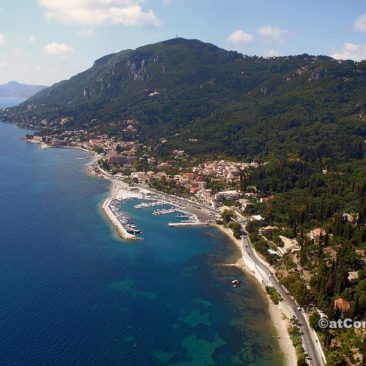



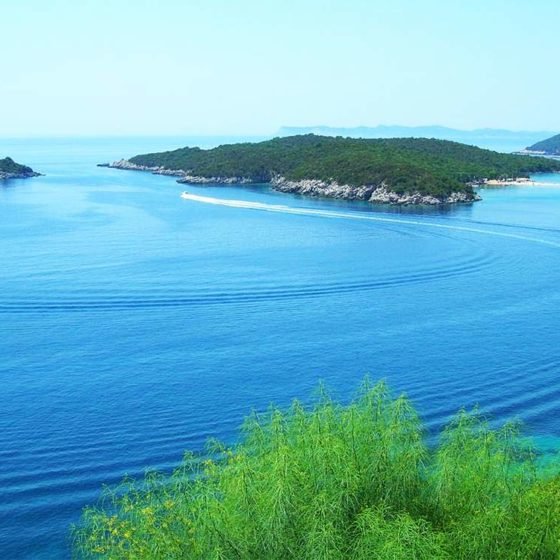

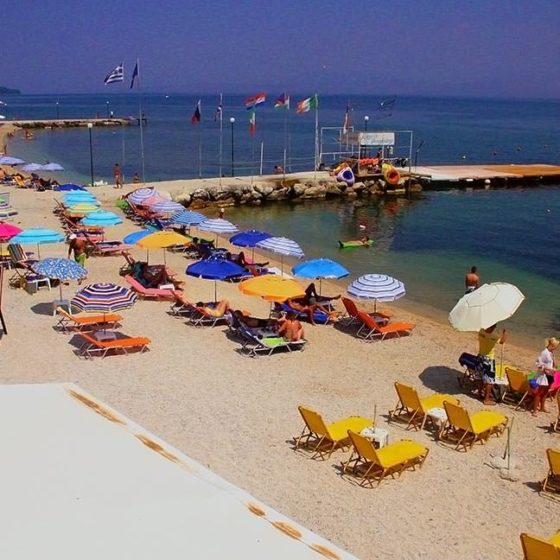









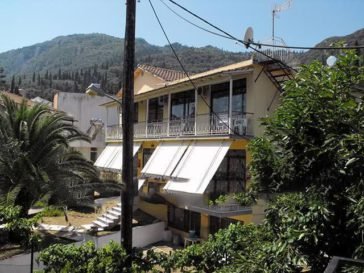

Comments